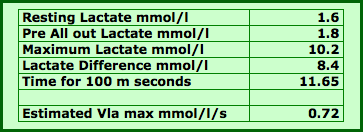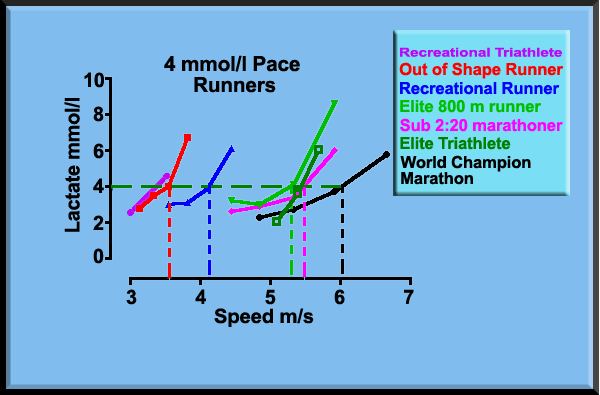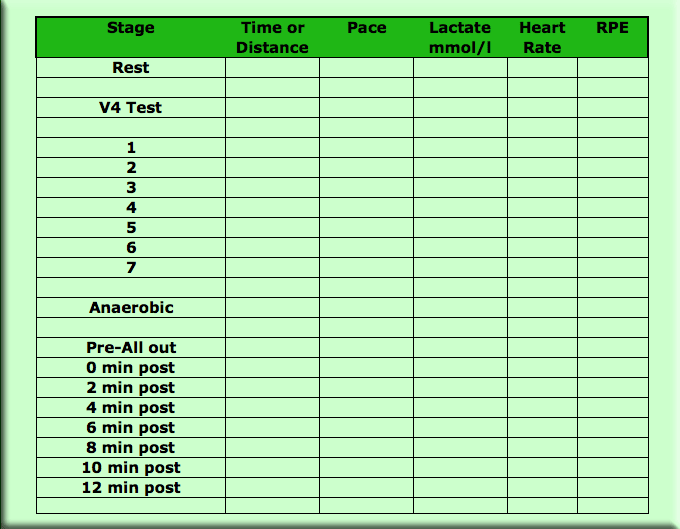
Basic Lactate Testing Video
Questions and answers
Click here for the youtube video.
We have produced a video that will help you better understand the basics of lactate testing for athletes.
- The video is not a complete explanation of everything that has to be done for a lactate test but is a good framework for understanding the purpose of the test and what has to be considered.
- The test has two components, an aerobic portion and an anaerobic portion. Will each test provide a completely accurate estimate of the aerobic and anaerobic capacity of the athlete? The answer is no but it will closely approximate these capacities if carefully done. Some sports scientists have software and protocols that provide very accurate estimates of both aerobic and anaerobic capacity.
Here are some typical questions that coaches have about lactate testing and our recommened protocol
- Why do both tests?
An optimal performance depends on both the aerobic and anaerobic capacity. Optimal performance requires that the athlete's aerobic capacity be maximal. However the athlete's anaerobic capacity should rarely be at a maximal level except for some very short races. The strength of the anaerobic system will affect the lactate curve and performance for both short events and long endurance events.
It is possible to maintain the athlete's aerobic capacity at the same level but make the athlete slower or faster in any event just by changing the anaerobic capacity of the athlete. This is true for an event that is less than a minute long such as a 100 m freestyle in swimming or as long as an Ironman triathlon. When talking about anaerobic capacity, we are talking about the strength of the glycolytic system or what is called glycolytic capacity.
Click here and go to to our animation describing the interaction of the aerobic and anaerobic systems to see how these systems affect each other and the lactate curve.
The anaerobic test is not necessary for a recreational athlete; the aerobic test will suffice for an athlete of this level. An example would be someone preparing for a marathon, 10k, local road race or a triathlon that wants to do better but whose aerobic capacity is far from maximal and also does not have the time to train to raise aerobic capacity to anywhere near maximal. For a serious athlete whose aerobic capacity is well developed, the anaerobic test is essential for understanding what has to be done to optimize training. - Please describe the anaerobic test in detail.
The test on the video is for running and is an all-out effort for 100 m. Actually the test could be a little shorter, approximately 80 m will do just as well and might be better. Here are the steps and the calculation for a sample test:- The athletes warms up and then rests for a couple minutes. A lactate reading is taken before the warmup and after the short rest, just before the all out sprint. The purpose of the resting lactate before the warmup is to make sure the pre-sprint lactate which will be used to calculate the VLa max is not too high after the warmup.
- The athlete runs for 80 m or 100 m as fast as possible. Just make sure that the same distance is used each time for the same athlete. Record the time for the sprint. Take a lactate immediately after the sprint. Then take a lactate reading every 2 minutes till 12 minutes. Record each reading for the athlete.
Use the maximum of the post lactate readings. If you see the lactate reading decling quickly there is no reason to take another reading even if it is still before the 12 minute time. - Calculate an estimate for what is known as the VLa max. For example, suppose the pre sprint lactate reading was 1.8 mmol/l, the maximum post sprint lactate reading was 10.2 mmol/l and the time to complete 100 m was 11.65 second.
Take the difference between the high reading and the reading just before the sprint. This is 10.2 mmol/l - 1.8 mmol/l = 8.4 mmol/l
Divide 8.4 by 11.65 to get .72 or the athlete has an estimated VLa max of .72
- At a later time, 6 weeks later (timing depends on training needs), the athlete repeats the test and has the following resultts:
The pre-sprint lactate is 1.6 mmol/l, the maximum lactate after 100 m is 8.7 mmol/l and the time to complete 100 m is 11.92 seconds. The new calculation is the difference (8.7 mmol/l -1.6 mmol/l or 7.1 mmol/l) divided by the time or 7.1/11.92 = .60. - If the athlete's aerobic capacity is the same, this athlete will have a higher threshold and be faster at an endurance race.
- For a triathlon coach's expereince with VLamax click here
- But everyone tells me the 4 mmol/l measure or V4 is not the lactate threshold. So why should I measure it?
- Yes, the 4 mmol/l measure or V4 (pace that generated 4 mmol/l of lactate) is not necessarily the lactate threshold. The lactate threshold or maximum lactate steady state usually ranges from just above 2 mmol/l to 6 mmol/l for different athletes in different sports. At first it was thought that the V4 measure was the lactate threshold but research quickly proved it wasn't for most athletes.
- So why measure the V4? The answer is that it predicts performance in distance events as well as the lactate threshold predicts performance. And it is easy to measure where measuring the lactate threshold is problematic. So why worry about measuring the threshold when a quicker measure provides the same information. Below is a chart which shows how the V4 will vary by different levels of ability.

- Does the V4 measure aerobic capacity? It is not an exact measure but it is a good indication of aerobic capacity. In the example above of the runners, as the curve moves to the right, aerobic capacity is generally increasing. The marathoner probably has the highest aerobic capacity or VO2max. For the three runners (800 m runner, elite triathlete and sub 2:20 marathoner) that have very similar V4's, their aerobic capacity is probably lower than the marathoner. But of these three runners, the 800 m runner probably has the highest aerobic capacity. Why?
- Do all coaches conduct lactate tests the same way we recommend?
No, there are lots of different protocols used by successful coaches and training advisers. We have provided what we consider the best approach for a coach who does not have a proprietary software system. Many coaches do not consider the anaerobic test in their testing. We believe it is a mistake not to do so. Many coaches adjust for anaerobic capacity intuitively but few can do it precisely from athlete to athlete. Here is a statement by Sebastian Weber who is a training adviser to multiple Tour de France cyclists.
Glycolytic capacity – the unnoticed game changer in endurance performance. It might be the least known parameter for most athletes and coaches. However glycolytic capacity can influence everything that is important to a cyclist; fat metabolism, threshold power, recovery, carbohydrate sparing, stamina. It is often the main differentiator between a good and an excellent cyclist and between amateur and professional. Working with this parameter in training and monitoring helped multiple athletes win world championships– not only in cycling but also in swimming & ironman triathlon. (examples of how glycolytic capacity affects race performance are discussed on our cycling page.)
Shannon Grady has had great success with her approach to testing and training. Shannon works mainly with runners but also has had success with rowers, triathletes, some team sports and martial arts competitors as well as others. Here is a link to a podcast where she discusses her successes and her methods. She currently works with some of the most successful middle distance runners in the US. Click here for her website. - Are there proprietary software systems available that analyze the results.
There are proprietary software programs that will provide the coach with an assessment of both the athlete's aerobic and anaerobic capacity. There are some that consider several other measurements besides these two measures. These are only currently available through three training advisers that we know (Jan Olbrecht, Shannon Grady and Sebastian Weber.) - Are these software programs necessary to use lactate testing.
No. Most coaches do not use any software and are still able to use lactate testing effectively. The CD we provide to all our users and the examples on our website provide more than enough information for the interested coach.
Lactate testing is not magic. It is however, the best report card on the status of the athlete's aerobic and anaerobic systems and the success of the training program in changing the development of these systems. Lactate testing does not make an athlete better, appropriate training does that. But what is the appropriate training for the athlete? Lactate testing is one of the best tools a coach can have to determine just what the proper training is.
Click here to go to our page on steering and the path to optimal performance. - The basic lactate testing video shows a blood drop taken from the finger. Is this the preferred place to take a blood drop?
In the United States most coaches or sports scientists will take blood from the finger tip. In Europe, most will take it from the ear lobe. It is easier to take the sample from the finger and can be done by one's self. But there are advantages to the ear lobe. For example, it less likely to be affected by sweat or dirt during the test. On the CD there are detailed instructions on how to take a blood drop from the ear lobe.
In a laboratory setting when doing reaearch some will take it from a vein in the arm. This is not necessary to get a more accurate reading and something we do not recommend. - Do you recommend any procedures to record the data?
Often the coach or sport scientist is collecting more than the lactate reading while doing a lactate test. Click here to see an example of a form that could be used when conducting a test and some actual test data (scroll half way down page). Below is a similar form used to record data including the anaerobic test. This form can be modified to include other information such as VO2 results and change "pace" to "watts" for cycling and rowing. There is a section for the anaerobic test.

- Please submit any questions you have and we will try to answer them either in an email or on this page. There is a good chance that your question is answered on our website. For example, we have a large section of questions on lactate testing and how to use it and how to analyze results.
Click here to go to our Question site.
Our triathlon site has answers to many questions for endurance athletes and will provide guidance to those who are just interested in running or cycling. Click here to see the topics covered.